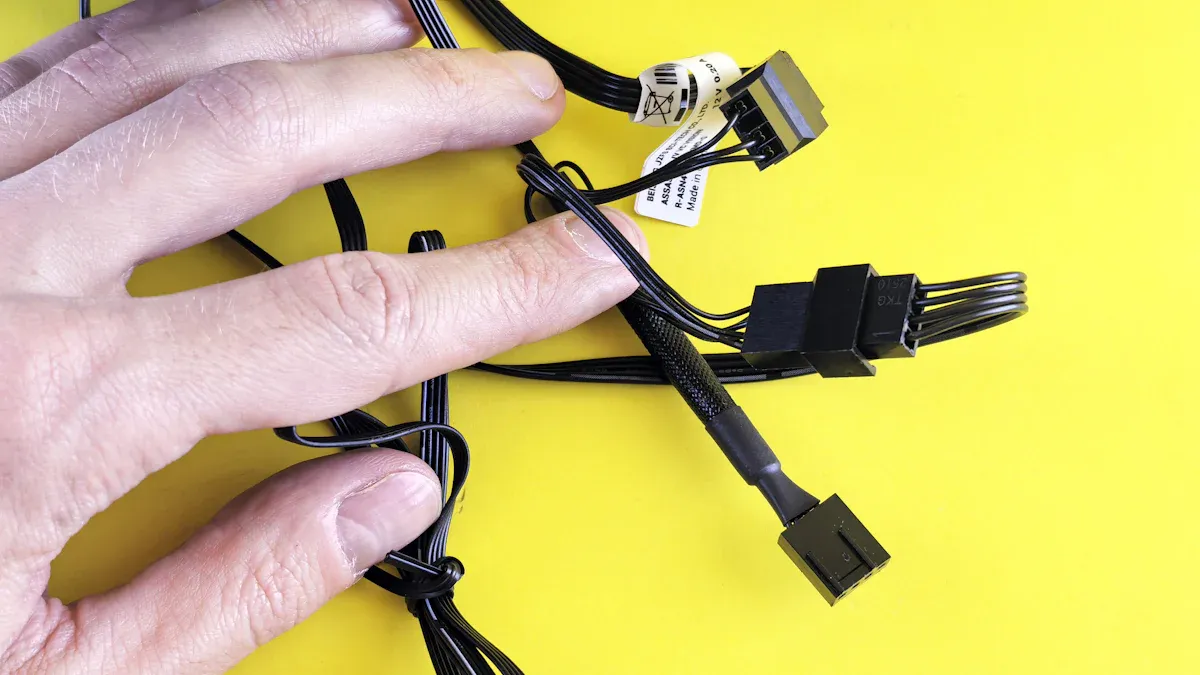
Small to medium businesses demand reliable power distribution. An apc basic rack pdu provides essential power distribution for SMBs in 2025. This guide details the top 10 models. It focuses on their suitability for diverse IT infrastructure needs. A Basic PDU offers foundational power for critical equipment. This differs significantly from an Intelligent PDU.
Key Takeaways
- APC Basic Rack PDUs give power to devices in server racks. They are important for small to medium businesses.
- Basic PDUs are different from Smart PDUs. Basic ones only give power. Smart ones can watch and control power.
- When choosing a PDU, check how many outlets you need. Also, look at the plug type and how much power it can handle.
- Vertical PDUs save space in your rack. Horizontal PDUs fit into standard rack slots.
- Always figure out how much power your devices need. This helps you pick the right PDU and avoid problems.
- Match the PDU’s outlets to your device power cords. This makes sure everything connects correctly.
- APC Basic Rack PDUs are reliable and strong. They offer good value for money for businesses.
- Properly install and manage cables for your PDU. This keeps your rack tidy and helps air flow better.
Understanding the Importance of APC Basic Rack PDUs for SMBs

What are APC Basic Rack PDUs and Their Role in SMB IT?
Essential Power Distribution for Rack-Mounted Equipment
APC Basic Rack PDUs provide fundamental power distribution for rack-mounted equipment. They offer various connections to distribute 120V, 208V, or 230V power to multiple outlets. These units supply power from one branch whip to many pieces of equipment. This conveniently powers rack-mount equipment. It also saves time and money during installation. They come in horizontal, vertical, and toolless-mount varieties, placing power directly in the racks near equipment. For instance, a model like the AP9562 provides basic power distribution with 10 outlets. It supports up to 15 Amps at 120V, offering 1.8kVA of power distribution. This is sufficient for most small to medium rack deployments.
Why Reliable Power is Crucial for SMB Operations
Reliable power is essential for small to medium business operations. Uninterrupted power ensures continuous operation of critical IT infrastructure. Power fluctuations or outages can lead to data loss, system downtime, and significant financial impact. A stable power supply, facilitated by a robust power distribution unit, protects valuable equipment. It also maintains productivity.
Distinguishing Basic PDUs from Advanced PDU Types
Basic PDUs differ significantly from advanced PDU types. Basic PDUs simply distribute power. They do not offer monitoring or switched outlet capabilities. They are suitable when advanced features are not necessary. In contrast, Intelligent or Smart PDUs collect data on power metrics. They enable monitoring, management, and control of power used by IT equipment. These advanced units connect to the network via a web interface, SNMP, SSH, or Telnet. They offer features like metering, which captures voltage, current, and power, and switching, which allows remote control of individual outlets. Basic PDUs offer a low-cost power distribution solution.
Key Features to Look for in an APC Basic Rack PDU for SMBs
Outlet Count and Types (C13, C19, 5-15R, 5-20R)
Consider the number and types of outlets. Common outlet types include C13, C19, 5-15R, and 5-20R. Some APC Basic Rack PDUs offer hybrid outlets, such as C13/C15 and C19/C21. A PDU might feature 21 C13 and 3 C19 outlets, for example. Matching PDU outlets to device power cords is crucial.
Form Factor and Mounting Options (1U Horizontal vs. 0U Vertical)
Form factor and mounting options are important for rack space optimization. PDUs come in 1U horizontal or 0U vertical configurations. Horizontal units fit into a standard 1U rack space. Vertical units mount along the side of the rack, saving valuable rack unit space. Many models include a toolless mounting kit for quick setup.
Input Plug Type and Amperage (10A, 15A, 20A, 30A)
The input plug type and amperage determine the power capacity. Common amperages include 10A, 15A, 20A, and 30A. Ensure the PDU’s input plug matches the available power source in your data center or server room.
Built-in Reliability and Durability
APC Basic Rack PDUs are known for their built-in reliability and durability. Models like the APC AP9562 are simple, strong PDUs. They ensure equipment receives steady power. The APC AP7540, for example, is designed to withstand demanding data center environments. It features a Zero U vertical mounting design.
Cost-Effectiveness and Scalability for Growing Businesses
Basic PDUs offer a cost-effective solution for small to medium-sized setups. They provide reliable power distribution at a lower price. They suit small-scale operations and low-density environments where simplicity and affordability are priorities. For growing businesses planning to scale, intelligent PDUs offer advanced features essential for scalability. However, an apc basic rack pdu provides a solid foundation for businesses needing reliable power distribution without advanced monitoring.
Top 10 APC Basic Rack PDUs for SMBs in 2025
APC Basic Rack PDU, 1U, 10A, (10)C13 (AP9562)
Ideal for Entry-Level Server Racks
The APC Basic Rack PDU, model AP9562, serves as an excellent choice for entry-level server racks. It provides reliable power distribution for essential IT equipment. This unit supports a nominal output voltage of 120V and handles a maximum total current draw of 15A, delivering a load capacity of 1400VA. Its design makes it perfect for foundational power needs in smaller IT environments.
Compact Design for Limited Space
This PDU features a compact 1U rack-mount design. It measures 1.73 inches (44MM) in height, 17.6 inches (447MM) in width, and 2.24 inches (57MM) in depth. Its light net weight of 5.51 lbs (2.5KG) further enhances its suitability for installations where space is a premium. The compact form factor ensures efficient use of valuable rack real estate.
Efficient Power for Standard IT Equipment
The AP9562 offers ten NEMA 5-15R output connections, making it compatible with a wide range of standard IT devices. It efficiently powers servers, network switches, and other common rack-mounted equipment. The unit operates with a nominal input voltage of 100V or 120V and includes a 12.14 ft (3.7 meters) cord with a NEMA 5-15P input connection. This configuration ensures stable and consistent power delivery.
Cost-Effective Solution for Small Setups
This model represents a cost-effective solution for small setups. It provides essential power distribution without unnecessary advanced features. Its robust construction and UL/cUL certifications ensure durability and safety. The AP9562 is ideal for server rack power distribution in small to medium data centers, network equipment power management in IT closets, and edge computing installations.
APC Basic Rack PDU, 1U, 15A, (14)5-15R (AP9567)
Versatile for Mixed Equipment Environments
The APC Basic Rack PDU, AP9567, offers significant versatility for environments with mixed equipment types. It provides 14 NEMA 5-15R outlets, accommodating a broader range of devices compared to C13-only models. This PDU handles a 15A input, making it suitable for various power requirements within an SMB.
Common Outlet Type for Office Devices
NEMA 5-15R outlets are the standard for many office and IT devices. This PDU simplifies power connectivity for equipment like desktop computers, monitors, and smaller network appliances. Businesses avoid the need for multiple adapter types, streamlining their power infrastructure.
Standard 1U Rack Integration
This PDU integrates seamlessly into any standard 1U rack space. Its horizontal mounting design ensures easy installation and accessibility. The 1U form factor allows businesses to maintain an organized and efficient rack layout.
Balanced Power for General SMB Use
The AP9567 delivers balanced power distribution for general SMB use. Its 15A capacity supports a moderate number of devices without overloading circuits. This PDU provides a reliable and straightforward power solution for growing businesses.
APC Basic Rack PDU, 0U, 16A, (20)C13 (EPDU1116B)
Space-Saving Vertical Mounting
The EPDU1116B model utilizes a 0U vertical mounting design. This configuration saves valuable rack unit space, which remains critical in dense server environments. It mounts along the side or rear of the rack, leaving the front 1U spaces free for active equipment.
Higher Density Outlet Configuration
This PDU offers a higher density of outlets with 20 C13 connections. This allows businesses to power numerous devices from a single power strip. The increased outlet count supports more equipment within the same rack footprint.
Optimized for Rack Side Installation
Engineers optimized the EPDU1116B for rack side installation. Its vertical orientation facilitates efficient cable management. This design reduces cable clutter and improves airflow within the rack, contributing to better equipment performance and longevity.
Suitable for Blade Servers and High-Density Racks
The high outlet density and vertical form factor make this an ideal apc basic rack pdu for blade servers and other high-density rack configurations. It efficiently distributes 16A power to multiple C13-compatible devices. This PDU meets the demands of modern, power-intensive IT infrastructure.
APC Basic Rack PDU, 0U, 20A, (24)5-20R
Increased Power Capacity for Growing SMBs
This apc basic rack pdu offers a 20A capacity. This increased power capacity supports the growth of small to medium businesses. As SMBs add more equipment, they need more power. This PDU provides the necessary power headroom.
Robust Standard Outlets for Higher Loads
The PDU features 24 NEMA 5-20R outlets. These outlets handle higher electrical loads than standard 5-15R outlets. Businesses can connect more robust servers and networking gear. This ensures stable power delivery to demanding devices.
Vertical Mount for Efficient Cable Management
Its 0U vertical mounting design saves valuable rack space. It mounts along the side of the rack. This placement helps organize power cables. Efficient cable management improves airflow and reduces clutter.
Future-Proofing for Expanding IT Needs
The 20A capacity and numerous outlets prepare SMBs for future expansion. Businesses can add new equipment without immediately upgrading their power infrastructure. This PDU supports evolving IT requirements.
APC Basic Rack PDU, 1U, 30A, (12)C19 + (12)C13
Mixed Outlet Types for Diverse High-Power Devices
This PDU provides a mix of 12 C19 and 12 C13 outlets. This combination supports a wide range of IT equipment. C13 outlets power standard servers. C19 outlets handle higher-power devices like blade servers or large switches.
High Amperage for Demanding Applications
A 30A input capacity makes this PDU suitable for demanding applications. It delivers substantial power to critical infrastructure. Data centers and high-performance computing environments benefit from this capacity.
Comprehensive Power Distribution in 1U
Despite its high capacity, this PDU fits into a standard 1U rack space. It offers comprehensive power distribution without consuming much vertical room. This design optimizes rack utilization.
Supporting Both C13 and C19 Power Requirements
The PDU supports both C13 and C19 power requirements. This eliminates the need for multiple PDU types. Businesses can power various devices from a single unit. This simplifies power planning and deployment.
APC Basic Rack PDU, 0U, 30A, (36)C13
Maximum Density Vertical Mounting Solution
This PDU offers a maximum density vertical mounting solution. It provides 36 C13 outlets in a 0U form factor. This design maximizes the number of available power connections within a rack.
High C13 Outlet Count for Numerous Devices
The high count of 36 C13 outlets serves racks with many standard IT devices. It powers numerous servers, switches, and other C13-compatible equipment. This PDU is ideal for dense deployments.
Ideal for Large-Scale Server Deployments
Businesses with large-scale server deployments find this PDU highly effective. It consolidates power distribution for many servers into one unit. This simplifies power infrastructure management.
Efficient Power Delivery for Dense Racks
Its vertical design and high outlet count ensure efficient power delivery in dense racks. It helps maintain organized cabling. This contributes to better airflow and overall rack performance.
APC Basic Rack PDU, 1U, 20A, (8)5-20R
Standard 1U Form Factor for General Use
This PDU fits into a standard 1U rack space. Its design allows for easy integration into existing server racks. Businesses find this form factor convenient for general use. It occupies minimal vertical space.
Robust and Reliable for Everyday Operations
The APC Basic Rack PDU, 1U, 20A, (8)5-20R, offers robust and reliable performance. It ensures consistent power delivery for daily operations. Its sturdy construction withstands the demands of a busy IT environment. This reliability minimizes downtime risks.
Balanced Power for Medium-Sized Racks
With a 20A capacity and eight 5-20R outlets, this PDU provides balanced power. It suits medium-sized racks. Businesses can power a moderate number of servers, switches, and other devices. This PDU prevents circuit overloads.
Simplicity and Durability in Design
This PDU features a simple, durable design. It focuses on core power distribution without complex features. Its straightforward functionality makes installation and management easy. The unit’s robust build ensures long-term service.
APC Basic Rack PDU, 0U, 15A, (16)5-15R
Vertical Mount for Smaller Racks
This PDU utilizes a 0U vertical mounting design. It is ideal for smaller racks where space is at a premium. The vertical orientation allows installation along the side of the rack. This saves valuable horizontal rack units.
Accommodates Many Standard Devices
With 16 NEMA 5-15R outlets, this PDU accommodates many standard devices. It powers common office equipment and smaller IT components. Businesses can connect numerous devices to a single power source.
Efficient Space Utilization in Compact Setups
The 0U form factor ensures efficient space utilization in compact setups. It maximizes the available rack space for active equipment. This design helps maintain an organized and clutter-free environment.
Cost-Effective for Basic Vertical Power Needs
This PDU offers a cost-effective solution for basic vertical power needs. It provides essential power distribution without advanced features. Small businesses benefit from its affordability and space-saving design.
APC Basic Rack PDU, 1U, 10A, (8)C13
Compact and Cost-Effective for Minimal Rack Space
This PDU is compact and cost-effective. It requires minimal rack space, fitting into a 1U slot. Its small footprint makes it suitable for environments with limited room. This unit provides an economical power solution.
Basic Power Needs for Smallest IT Footprints
The 10A capacity and eight C13 outlets meet the basic power needs of the smallest IT footprints. It powers essential equipment in small offices or edge deployments. This PDU supports foundational IT infrastructure.
Reliable Performance for Essential Equipment
This PDU delivers reliable performance for essential equipment. It ensures a stable power supply to critical devices. Businesses depend on its consistent operation to maintain uptime.
Entry-Level PDU with Essential Features
This model serves as an entry-level PDU. It offers essential power distribution features without complexity. It is a straightforward choice for businesses seeking dependable power for their basic rack setups.
APC Basic Rack PDU, 0U, 30A, (24)C13 + (6)C19 (EPDU1132B)
High Power and Density for Demanding SMB Environments
The APC Basic Rack PDU, model EPDU1132B, delivers high power and density. It suits demanding small to medium business environments. This unit provides a robust 30A input. It efficiently powers numerous devices within a single rack. Businesses with growing IT infrastructure benefit from its substantial capacity. This PDU ensures stable power delivery to critical equipment. It supports continuous operation for essential services.
Mixed Outlets for Comprehensive Device Support
This PDU features a versatile mix of outlets. It includes 24 C13 outlets and 6 C19 outlets. This combination offers comprehensive support for diverse IT equipment. C13 outlets power standard servers and network devices. C19 outlets handle higher-power equipment like blade servers, large switches, and storage arrays. Businesses avoid the need for multiple PDU types. This simplifies power management and inventory.
Advanced Vertical Power Distribution
The EPDU1132B utilizes an advanced 0U vertical mounting design. This configuration optimizes rack space. It mounts along the side or rear of the rack. This leaves valuable 1U spaces free for active IT gear. Vertical mounting also facilitates superior cable management. It reduces cable clutter and improves airflow within the rack. Better airflow contributes to equipment longevity and performance. This design makes it an ideal apc basic rack pdu for modern data centers.
Scalable for Future High-Power Requirements
This PDU offers excellent scalability for future high-power requirements. Its 30A capacity provides ample headroom for expansion. As SMBs grow, they can add more power-intensive devices. The mixed outlet configuration also supports evolving hardware needs. Businesses invest in a power solution that adapts to their changing IT landscape. This PDU helps future-proof the power infrastructure. It ensures reliable power as demands increase.
How to Choose the Right APC Basic Rack PDU for Your SMB
Selecting the correct apc basic rack pdu is crucial for efficient power distribution. Businesses must carefully assess their specific needs. This ensures reliable operation and supports future growth.
Assessing Your Power Requirements for an APC Basic Rack PDU
Calculating Total Wattage and Amperage Needs
Accurately calculating power needs prevents overloads and ensures system stability. Businesses use specific formulas to determine wattage and amperage.
- General Calculation: Use the formula W/V=A. Here, W represents the wattage rating from device documentation. V is the voltage, such as 208 Volts. This formula determines amperage.
- Single-Phase Rack PDU: Total Power equals (Total Current) multiplied by (208V).
- Three-Phase Rack PDU: Total Power equals (Total Three Phase Current) multiplied by (208V) multiplied by [sqrt(3)].
- Multi-Bank PDUs (e.g., AP8868): Calculate the single-phase power for each bank. Then, sum these values to get the ‘Total Three Phase Current’.
- Required Input Values: Gather the total power consumption of all connected devices in watts or kilowatts. Also, note the line-to-line voltage (e.g., 208V, 400V, or 480V). Finally, identify the power factor, which typically ranges between 0.8 and 1.0.
Understanding Input Voltage and Phase
Input voltage and phase directly impact PDU selection. APC Basic Rack PDUs offer diverse input and output connections. They distribute 120V, 208V, or 230V power.
- These PDUs adapt to varying power requirements. Options include 100-125VAC acceptable input voltage.
- Specific models are available with nominal input voltages of 100V and 120V.
- The maximum input current for some models reaches 15A. They operate with an input frequency of 50/60 Hz.
Planning for Future Growth and Scalability
Businesses must consider future expansion. Choose a PDU with capacity beyond current needs. This prevents costly upgrades later. Scalability ensures the power infrastructure supports new equipment.
Determining Required Outlet Types and Quantities for Your APC Basic Rack PDU
Matching PDU Outlets to Device Power Cords (C13, C19, NEMA)
Match PDU outlets to device power cords. Common types include C13, C19, and NEMA. Ensure compatibility for all equipment. This avoids the need for adapters.
Ensuring Sufficient Outlets for Current and Future Devices
Count the number of devices requiring power. Add extra outlets for future equipment. This prevents power strip daisy-chaining, which can be unsafe.
Considering Redundancy for Critical Equipment
For critical systems, consider redundant power paths. This involves using two PDUs for essential devices. Redundancy ensures continuous operation if one power source fails.
Evaluating Form Factor and Mounting Options for APC Basic Rack PDUs
1U Horizontal Mounting for Standard Racks
1U horizontal PDUs fit into standard rack units. They are common for general use. These units are easy to install in existing rack setups.
0U Vertical Mounting for Space Optimization
0U vertical PDUs mount along the side of the rack. They save valuable rack unit space. This option is ideal for dense environments.
Impact on Rack Space and Airflow
The choice of form factor affects rack space and airflow.
| Feature/Option | 1U Horizontal PDU | 0U Vertical PDU |
|---|---|---|
| Space Consumption | Consumes rack space (1U or 2U), creating capacity management challenges. | Does not take up rack space, mounted in ‘zero U’ space. |
| Outlet Density | Typically 6 to 16 outlets; lower outlet count. | Provides as many as 60 outlets; higher outlet density. |
| Airflow/Cooling | Designed to operate at lower temperatures, requiring cooling like IT equipment. | Designed to withstand higher temperatures from hot air exhaust; low-profile design improves airflow. |
| Maintenance/Reliability | Failure typically requires removal and replacement, leading to unplanned downtime. | Hot-swappable components allow repair/upgrade without interrupting power. |
| Cable Management | May be chosen if limited space in the back of the cabinet for cable management. | Low-profile designs leave plenty of room for cable management. |
| Power Loads | Good choice for lower power loads. | Can handle greater heat loads. |
| Network Connectivity | Older units require a separate network, increasing equipment and administrative overhead. | Can be daisy-chained for network connectivity, using one port/IP for multiple units. |
Budget Considerations and Long-Term Value of an APC Basic Rack PDU
Initial Investment vs. Total Cost of Ownership
Businesses must look beyond the initial purchase price when selecting an apc basic rack pdu. The Total Cost of Ownership (TCO) provides a complete view of the investment. TCO includes the upfront cost, warranty coverage, and the long-term operational value. Analyzing TCO helps businesses choose a PDU that offers the best value throughout its entire lifespan. The initial purchase price of a PDU varies significantly based on its features. Basic PDUs are generally the most affordable. More advanced models, such as switched PDUs with outlet-level monitoring, come at a higher cost. APC Basic Rack PDUs offer low-cost power distribution. They provide multiple outlets to supply power to rack equipment at an affordable price.
Here is a look at some APC PDU models and their typical prices:
| Model | Input | Output | Price |
|---|---|---|---|
| AP7530 | 100V, 120V (NEMA L5-20P) | 120V (24) NEMA 5-20R | $269.00 |
| AP9562 | 100V, 120V (NEMA 5-15P) | 120V (10) NEMA 5-15R | $99.00 |
| AP9567 | 100V, 120V (NEMA 5-15P) | 100V, 120V (14) NEMA 5-15R | $179.00 |
| AP9559 | 200V, 208V, 230V (IEC-320 C20) | 120V, 208V, 230V (10) IEC 320 C13, (2) IEC 320 C19 | $219.00 |
Reliability and Brand Reputation (APC by Schneider Electric)
APC by Schneider Electric holds a strong reputation for reliability in the IT industry. Choosing a PDU from a reputable brand ensures consistent performance and durability. APC products undergo rigorous testing. This guarantees they meet high standards for power distribution. Businesses can trust APC PDUs to provide stable power to their critical equipment. This reliability minimizes downtime and protects valuable IT assets. Investing in a well-known brand like APC often translates to better long-term value and peace of mind.
Avoiding Over-Specifying or Under-Specifying
Businesses must carefully match PDU capabilities to their actual needs. Over-specifying means purchasing a PDU with more features than necessary. This leads to unnecessary costs. For example, buying a smart PDU when a basic one suffices wastes budget. Conversely, under-specifying involves choosing a PDU that lacks essential features or capacity. This can result in power outages, equipment damage, or the need for premature upgrades. A thorough assessment of current and future power requirements helps businesses select the right PDU. This ensures optimal performance and cost-effectiveness.
Installation and Maintenance Tips for Your APC Basic Rack PDU

Proper installation and consistent maintenance ensure the longevity and reliability of your power infrastructure. Businesses must follow best practices for their power distribution units. This prevents downtime and protects valuable equipment.
Proper Mounting Techniques for APC Basic Rack PDUs
Secure Horizontal Installation in 1U Space
Businesses often install 1U horizontal PDUs in standard rack units. They secure these units using the provided mounting hardware. Technicians ensure all screws are tight. This prevents movement and maintains stability. Proper horizontal placement allows for easy access to outlets and circuit breakers.
Best Practices for 0U Vertical Mounting
0U vertical PDUs mount along the side or rear of the rack. This method saves valuable rack unit space. Installers attach these units to the rack frame using toolless mounting kits or screws. They ensure the PDU does not obstruct airflow or interfere with other equipment. Vertical mounting also facilitates better cable management.
Ensuring Stability and Accessibility
Regardless of the mounting style, stability is paramount. A securely mounted PDU prevents accidental disconnections. It also reduces stress on power cables. Installers ensure the PDU remains accessible for routine checks and maintenance. This includes clear visibility of indicator lights and easy access to outlets.
Effective Cable Management with APC Basic Rack PDUs
Preventing Cable Clutter and Improving Airflow
Effective cable management is crucial for optimal rack performance. APC server racks include cable management systems with improved channels. These systems direct cables smoothly and efficiently. This eliminates clutter and enhances airflow. Unobstructed airflow prevents hotspots. It also improves cooling efficiency. Planning the layout by allocating rack space for all equipment helps. Businesses consider rack units and spatial dimensions for airflow and maintenance access.
Labeling and Organizing Power Cables
Organizing cables involves labeling them clearly. This makes identification and troubleshooting easier. Technicians use cable ties or Velcro straps to keep cables tidy. They also separate power and data cables to prevent interference. This practice maintains an organized and efficient environment.
Utilizing Cable Management Accessories
Businesses utilize various cable management accessories. These include cable management trays, ties, or channels. These tools sort cables and minimize clutter. Employing vertical PDUs also saves space and avoids blocking airflow. This contributes to better cooling and overall rack health.
Basic Troubleshooting and Care for APC Basic Rack PDUs
Understanding Power Indicator Lights
APC Basic Rack PDUs feature indicator lights. These lights provide immediate status updates. A green light typically indicates normal operation. A red light or no light might signal a problem. Businesses train staff to interpret these indicators. This allows for quick identification of potential issues.
Environmental Considerations (Temperature, Humidity)
Temperature and humidity significantly impact PDU performance. High temperatures reduce equipment performance and lifespan. Low temperatures can cause condensation. This risks short circuits. Maintaining optimal temperature and humidity levels is essential. This ensures the reliability of rack PDUs. It also prevents overheating. Environmental sensors can catch problems early.
Regular Visual Inspections
Data center managers should inspect rack PDUs regularly. High-risk environments require monthly checks. Medium-risk areas should have quarterly inspections. Low-risk environments can be inspected twice a year. Operators look for signs of an overloaded circuit. These signs include frequent breaker trips or unusual heat around the PDU. Addressing these issues immediately prevents equipment damage.
The Future Role of APC Basic Rack PDUs in SMB IT Infrastructure
Evolving Power Demands in SMB Data Centers
Increased Device Density and Virtualization
Small to medium businesses continually increase device density within their server racks. Virtualization technologies allow more virtual machines to run on fewer physical servers. This consolidation leads to higher power demands per rack unit. SMBs must manage this increased power consumption effectively.
Higher Power Consumption of Modern Hardware
Modern IT hardware, including powerful servers, storage arrays, and networking equipment, consumes more power. These devices offer enhanced performance but require robust power delivery. Businesses need reliable power infrastructure to support these advanced components. This trend highlights the importance of capable power distribution units.
The Enduring Need for Reliable Basic Power
Despite evolving demands, the fundamental need for reliable power distribution remains constant. Even with advanced hardware, every device requires a stable power source. An apc basic rack pdu provides this essential foundation. It ensures continuous operation for critical IT systems.
Integration and Complementary Solutions for APC Basic Rack PDUs
Basic PDUs as the Foundation for Smart Racks
Basic PDUs serve as the foundational layer for smart racks. They provide the essential power outlets for all equipment. Even in environments with advanced monitoring and management, basic PDUs deliver the raw power. They ensure every device receives necessary electricity.
Pairing with UPS Systems for Uninterrupted Power
APC Basic Rack PDUs integrate seamlessly with other IT infrastructure solutions. Schneider Electric offers a complete range of integrated IT infrastructure solutions. These include PDUs and UPSs. They work together as a seamless ecosystem. PDUs provide power distribution and management to IT racks. UPS solutions safeguard business operations. They protect critical IT from unstable power conditions. This integrated approach ensures business continuity. It also optimizes critical IT environments. This applies whether in small commercial spaces or high-density server rooms. APC’s PDU offerings, from basic to intelligent, ensure resilient power distribution. They complement the protective role of APC UPS solutions.
The Continued Relevance of Basic Functionality
Basic PDUs maintain their relevance in SMB IT infrastructure. They offer straightforward power distribution without complex features. Many SMBs prioritize simplicity and cost-effectiveness. Basic PDUs fulfill these requirements efficiently. They provide dependable power, which remains a core necessity for all IT operations.
Reliable power distribution is essential for SMB operational continuity. An apc basic rack pdu plays a critical role in maintaining uptime. Businesses must carefully consider key factors when selecting a PDU. These include outlet types, form factors, and power capacity. This guide detailed the top 10 models for 2025. SMBs can now make informed decisions. They will achieve robust and scalable power distribution for their evolving IT infrastructure.
FAQ
What is an APC Basic Rack PDU?
An APC Basic Rack PDU distributes power to multiple devices in a server rack. It provides essential power without advanced monitoring or switching features. Businesses use them for reliable, straightforward power delivery to IT equipment.
Why should SMBs choose APC Basic Rack PDUs?
SMBs choose APC Basic Rack PDUs for their reliability, durability, and cost-effectiveness. APC is a trusted brand. These PDUs offer essential power distribution. They meet the fundamental needs of small to medium businesses without unnecessary complexity.
What is the difference between 1U Horizontal and 0U Vertical PDUs?
1U horizontal PDUs mount in a standard 1U rack space. 0U vertical PDUs mount along the side of the rack. Vertical PDUs save valuable rack unit space. They often offer higher outlet density. 💡
How do I determine the correct outlet types for my PDU?
Match PDU outlet types (e.g., C13, C19, 5-15R, 5-20R) to your equipment’s power cords. Check device specifications. Ensure compatibility for all connected hardware. This prevents the need for adapters.
What amperage PDU does my SMB need?
Calculate the total amperage of all connected devices. Add a buffer for future growth. Common amperages include 10A, 15A, 20A, and 30A. Match the PDU’s amperage to your power source capacity.
Can I upgrade a Basic PDU to a Smart PDU later?
No, users cannot upgrade a Basic PDU to a Smart PDU. Basic PDUs lack the internal hardware for monitoring and network connectivity. Businesses needing advanced features should invest in Smart PDUs from the start. ⚠️
Are APC Basic Rack PDUs reliable for critical equipment?
Yes, APC Basic Rack PDUs offer high reliability. They provide stable power distribution. Their robust construction ensures durability. Many SMBs trust them for essential IT infrastructure. They are a solid foundation for critical equipment. ✅



